BUYING AN ENGAGEMENT RING ON AMAZON???
YOUR GUIDE TO BUYING A DIAMOND SOLITAIRE ENGAGEMENT RING ON AMAZON
This post contains affiliate links. If you use these links to buy something I may earn a commission. Thanks! As an Amazon Associate I also earn from qualifying purchases.
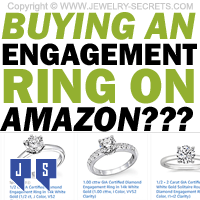
Amazon?
Buying a diamond engagement ring on Amazon?
Seriously, if you look at the stars and comments that people leave on Amazon, you’ll see, hundreds of people do it every single day.
But, before you hit that “Add to Cart” button, STOP!
Read This First
Because there are some things that you should know, before you make that big ring purchase.
First of all, buying a diamond solitaire, or any diamond engagement ring on Amazon isn’t going to be cheaper (like some would think). It won’t. Diamond prices are pretty much the same across the board. You could get these exact same prices at any local jewelry store.
What you will get is variety. Amazon sells everything. So finding something unique, different, set in rose gold, is going to be pretty easy.
But Tread Carefully
Because the descriptions and titles on these products (not from Amazon, but the seller themselves) can be very misleading, vague, and often WRONG.
For example, if you do a search for “diamond solitaire engagement ring“, it brings up this…
You see you get a wide assortment of things, some things aren’t even engagement rings.
And even though you type in the word “DIAMOND“, many times what shows up is in fact NOT a diamond; but a diamond simulant, a diamond cut, or a CZ (sellers like to list CZ’s as CZ diamonds, so they show up when you type “diamond”)… CZ’s are not diamonds and should never be listed as one.
In other words, you get a mixed bag.
You get anything and everything… Sure you get some real diamonds, but you have to sort through the horde. And even if you type in “Genuine Diamond“, Amazon will show everything for the word “Genuine“, as in “it’s a genuine ring“, and “Diamond“, as in “it’s a diamond look-a-like“…
You really do have to be cautious and read everything!
Also keep in mind that many reviews on Amazon are not REAL. Many are fake and created by the person that’s selling the item. So take that with a grain of salt (Amazon does try to prevent this). Usually the “REAL” reviews are the ones where they are sincere and sound truthful, versus saying “This is the best ring, at the best price, that you could ever buy” Yeah, right!
See what I mean?
So here are some tips on buying an engagement ring on Amazon, and not being taken advantage of.
Tips on Diamond Ring Shopping:
Here we go…
Buy GIA
If you alter your diamond search a little, and search for “diamond solitaire engagement ring GIA” instead, you’ll get a much better selection of rings to choose from. Definitely more expensive (because GIA is the most strict, and most accurate diamond grading company in the world), but I would trust no others.
I would never buy a IGI or an EGL.
Ever! After seeing certified diamonds over the past 30 years, I know that IGI and EGL are very lenient and very lax in their gradings, and are often OFF by an entire grade or TWO.
So if you’re serious about buying a diamond and not getting ripped off, make sure it’s listed as GIA certified! (and that it comes with the official report, and not a COPY, or SAMPLE of one).
Make sure it’s GENUINE
As I already stated, make sure that the diamond you’re buying is genuine. A real diamond, and not some “man made” diamond or “diamond simulant” or “created stone“. You want a real diamond for an engagement ring and nothing else. Period. So read the description well and use some common sense. If they’re selling a 1.00 carat diamond ring for $329… IT’S NOT REAL!
Be Leery of I Clarity Diamonds
People always feel bamboozled when they buy an I clarity diamond. This is because they either don’t know what I clarity means, they don’t care what it means, or they weren’t told what they were buying at the time of purchase (some people only see the price tag).
I clarity (which is I1, I2 or I3 diamonds) are low quality diamonds, with clarity that isn’t so pretty. I clarity means INCLUDED. The diamond WILL be full of inclusions (which is why they’re in the lowest clarity range possible), and YES, you will be able to see these inclusions with the naked eye (no loupe necessary).
Let me Repeat:
When you look at an I clarity diamond, you WILL be able to see flaws with the bare eye. It could look cloudy, foggy, have huge black spots… It could even look like a piece of SALT. No lie. The diamond could look like it’s fractured, chipped, cracked… I clarity has eye-visible imperfections.
So before you dive into that CHEAP price… know this:
You’re Buying FLAWS!
Many of them. If you don’t want your fiancee to see dark spots (often looking like pepper), cracked areas, lines, or feathers, then you’ll have to buy SI clarity instead. SI is the next clarity range up the ladder and it’s what I recommend buying the most because of looks and price.
SI (SI1 and SI2) still have inclusions, but they are microscopic only. You’ll have to use magnification (like a microscope or a 10x jeweler’s loupe) to see them. That’s GOOD!
So searching for “diamond solitaire engagement ring SI GIA” instead, puts you into a much better diamond.
Almost All the Images are Stock Photos
90% of the rings you see on Amazon (and many other jewelers online and in fliers and catalogs), are NOT the ring you’ll actually get. They’re stock photos, meaning, it’s the same sample photo they use (regardless of quality) for each and every ring shown.
See the example below when I add (princess) to the description:
Those are not the real rings you’d get. In those photos the diamonds look clean, clear, beautiful, full of brilliance, life, and sparkle… But in actuality, you’d probably get something much, much different (and worse). It all depends on the color and clarity you choose.
What about CUT?
Cut is usually always missing. So many stores SKIP cut, it’s crazy. Even brick and mortar stores. They almost always skip over cut, saying nothing more than “it’s a brilliant cut“, or “it’s princess cut“…
That’s Not Cut!
Cut is the way a diamond is proportioned. It’s the way the diamond interacts with light and makes a diamond sparkle. In fact, cut plays the biggest role in how a diamond sparkles. The better the diamond is cut, the more that diamond will sparkle. Easy as that. So if you truly want a diamond that sparkles like a million stars in the sky, look for the “cut grade“. Cut grades (GIA cut grades) are: Excellent, Very Good, Good, Fair, Poor.
Excellent is the Best.
Very Good; second best. But I would always opt for “Excellent” if it were me buying a diamond, just so it has the maximum amount of brilliance, fire and scintillation possible.
You’ll find these cut grades listed on a GIA diamond report. Like the one shown below…
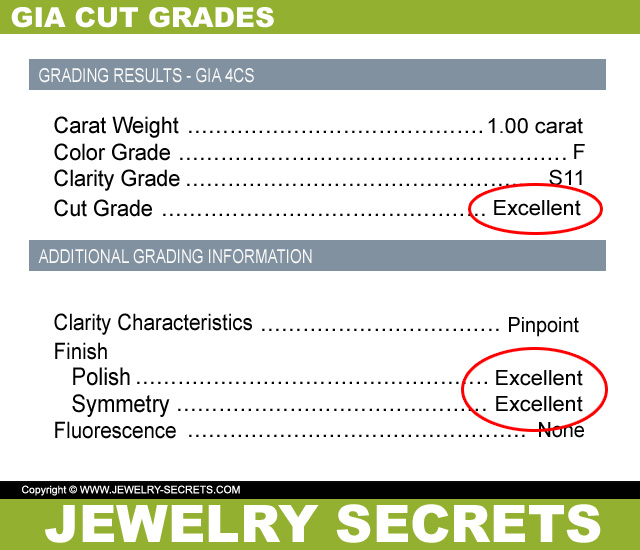
You’ll notice that I also have Polish and Symmetry circled as well. Those are graded the same way CUT is, and are actually pretty important to how a diamond sparkles too.
When you combine the Cut grade, with the Polish and Symmetry grades, you get the best cut diamonds in the world. Also known as “triple excellent diamonds“, and often sold as “hearts and arrows” or “hearts on fire” or “true hearts” diamonds… The best of the best. The cream of the crop.
Shop and Compare
Always, always compare quality and diamonds with different stores, online and in store. That way, you’ll truly know if you’re getting a great deal, or getting ripped off.
One of my favorite places to check prices with is James Allen, their prices are low, everything they sell is certified, and you get to see the REAL diamond, close up (magnified 40 times)… And you can spin the diamond around and see it from all angles. It’s amazing.
Check with the mall stores, check online with Blue Nile, compare similar qualities to see how the price varies. It’s a real eye-opener.
Get it Appraised!
Make sure, if you buy a diamond ring online (or even in store), that you get a second opinion. Get the ring appraised (often this costs $70-$100), just to double check the clarity, color, carat weight, certificate, and cut. It’s crucial!
Make sure they have a Return Policy
If you can’t return it, DON’T BUY IT! Never buy a ring you can’t return (even if it’s just a couple days, a week, or a few months). You’ll want to be able to get a 100% full money back guarantee if the ring doesn’t turn out to be what’s stated.
Lastly…
Get it Insured!
Put the ring on your insurance policy (like renter’s insurance or home owners). That way if something were to happen to the ring, if the diamond falls out, if it gets stolen or lost, it’ll be covered.
Other Pointers…
- You’ll have to Pay for Sizing – Usually when you order online, you won’t know what her ring size is until you give it to her. Don’t worry. This can happen if you buy from a jewelry store as well. Just give her the ring and then have a local jeweler size it for you. They’ll probably charge you anywhere from $50-$100 to size it, depending on the type of metal. Platinum could be more.).
- Don’t Buy Silver – Silver tarnishes, is soft, and will turn yellow or stain your skin overtime. Invest in Gold or Platinum for an engagement ring instead.
- Read the Reviews – Make sure you read the Amazon reviews and see what other people are saying. Just note, as I’ve said above, that some of these reviews may be fictitious, and if it sounds too good to be true, it probably is.
- You get what you Pay for – If you’re buying a diamond ring for $800, you’re getting an $800 diamond ring. Generally, a normal engagement ring sells for around $3,000 on average across the country. And a normal 1.00 carat solitaire sells for $3,000 – $8,000, depending on quality. So if you try to save some bucks and buy inexpensive, you’re going to be sacrificing something. Whether it be carat weight, color, clarity or cut. Something will be sacrificed to drop the price down.
- Check Fluorescence as well – Fluorescence is a natural phenomenon that can occur in diamonds. It’s an identification trait that some diamonds have (30% of them), and others don’t. Fluorescence makes a diamond glow-in-the-dark (like a white shirt under UV light). And Fluorescence can also (not always) make a diamond look odd, or weird in natural light as well. Sometimes it can make a diamond look foggy, cloudy, or mirky. Hazy, like a mist. This isn’t good. It can block light, keep a diamond from sparkling, and just make it look low quality or dirty. So I usually tell people to make sure the diamond they buy does NOT have Fluorescence. It’ll list Fluorescence right on the GIA diamond report. Look for it.
And that’s the Guide
That’s the best way to get a great looking diamond and not get raked over the coals.
See all the GIA diamond engagement rings HERE!
And check out James Allen Diamonds HERE!
Cheers! :)


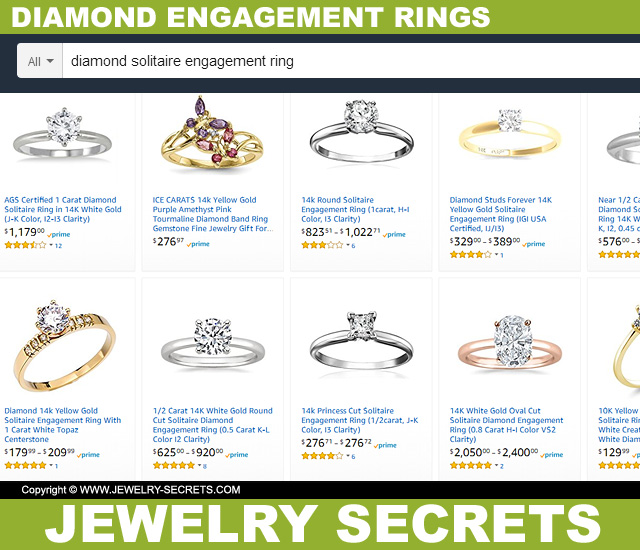
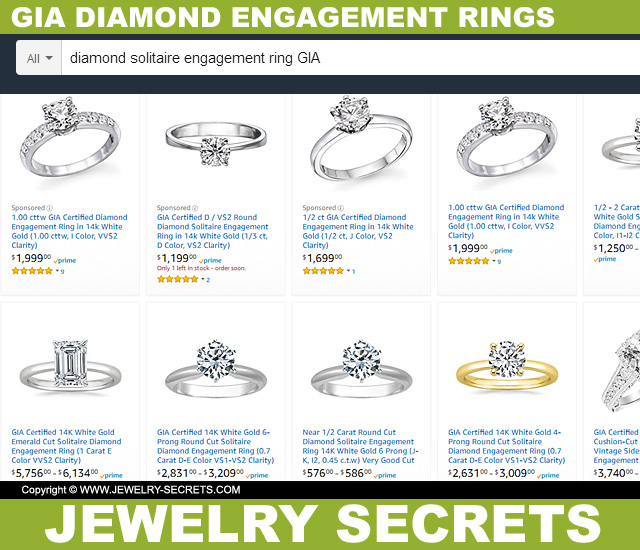
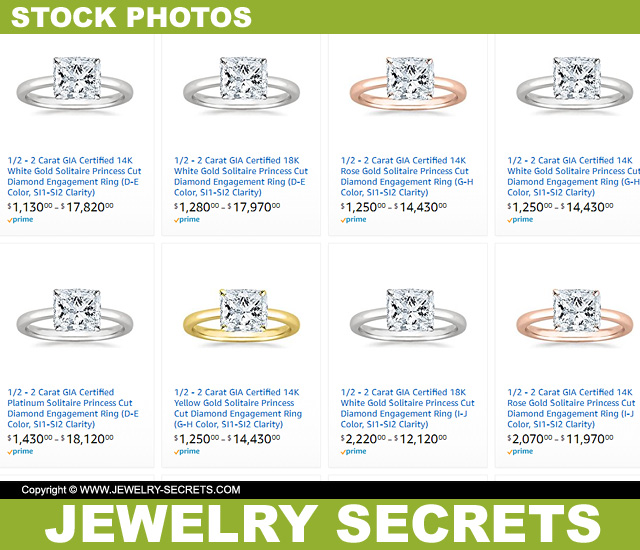
















Leave a comment